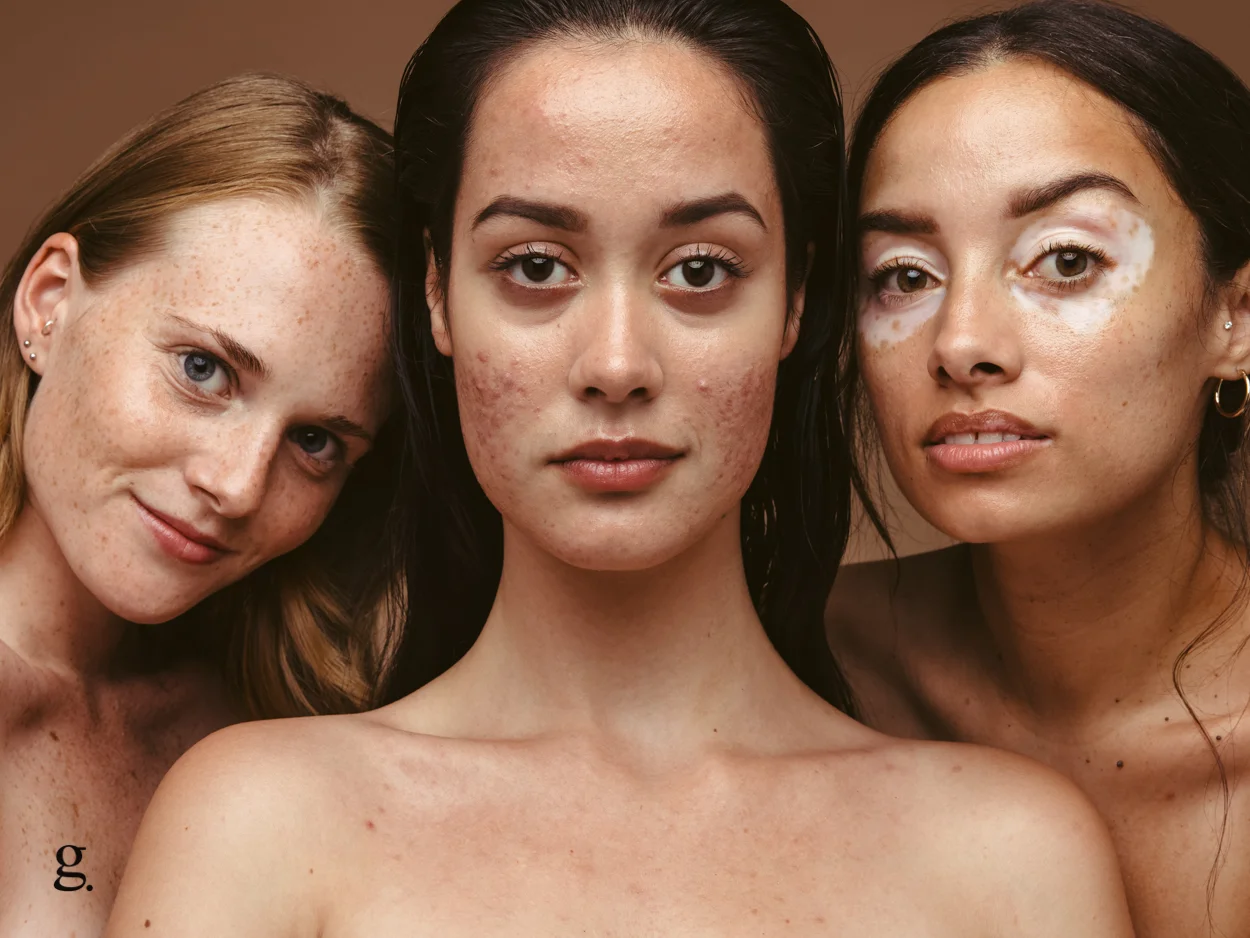Do you have oily skin in your T-zone, but dry patches on your cheeks? How about a greasy nose and forehead with clogged pores, but relatively dehydrated skin everywhere else? If you answered yes to any of these questions, then you probably have what’s known as a “combination” skin type.
While it can be difficult to care for properly due to it adding a little extra complexity to your skincare routine, do not worry, you’re not alone – this is the most common skin type.
Combination skin explained
Combination skin is, as the name implies, a mix of two different skin types – typically oily and dry (it may also be sensitive, acne-prone, etc., but we digress).
Although it can also technically be a combination of oily and normal skin, dry and normal skin, etc., for clarity’s sake, people are talking about oily and dry skin combo when they mention “combination skin”.
The main identifying feature of combination skin is that you have an oily T-zone (forehead, nose, and chin), while your cheeks are relatively dry.
Your T-zone may be prone to breakouts, blackheads, and shine, while your dry patches can feel tight, flaky, and irritated.
Your skin’s texture can also wildly vary when you have combination skin, as the dry patches can feel rough while the oily areas are usually quite smooth.
This skin type can be caused by several different factors, with the main cause simply being down to your genetics, however, climate, hormones, and other environmental factors may trigger your skin to become a combination of dry and oils.
Identifying combination skin: the characteristics
Determining whether you possess combination skin is a fairly straightforward process. By observing a few key indicators, you can quickly ascertain if your skin falls into this category:
An Oily T-Zone
The most prominent and easily distinguishable feature of combination skin is the presence of an oily T-zone. This region, which consists of your forehead, nose, and chin, forms the shape of the letter ‘T’. If you consistently notice a shiny appearance in these areas, accompanied by a greater tendency for breakouts or clogged pores, it is highly likely that you have combination skin.
Localized Dry Patches of Skin
Another characteristic of combination skin is the presence of localized dry patches. These generally appear on the cheeks but can also develop in other facial areas, such as around the eyes or along the jawline. Dry zones often feel tight and may exhibit visible flakiness or even redness, which can sometimes lead to irritation. This contrasting skin behavior is a strong indicator that you have combination skin.
Mixed Skin Texture
Combination skin is also characterized by noticeable variations in texture across different areas of the face. In the oily regions, such as the T-zone, skin usually feels smooth and supple due to the higher concentration of natural oils (sebum). On the other hand, the dry sections of your face may feel rough, coarse, or even bumpy to the touch, as a result of insufficient moisture levels or dead skin cell buildup. This contrasting texture is another key sign that you are dealing with combination skin.
Pore Size Variation
People with combination skin often experience variations in pore size across their face. The oily T-zone typically exhibits larger, more visible pores due to increased sebum production. Conversely, the drier areas of the face, such as the cheeks, may have smaller or less noticeable pores. This difference in pore size further confirms the presence of combination skin.
Sensitivity and Reactivity
Finally, combination skin can display increased sensitivity and reactivity to skincare products or environmental factors. You may find that certain products work well for the oily areas but exacerbate dryness in other parts of your face, or vice versa. This inconsistent response to skincare treatments and external elements is another indication that you have combination skin.
How to care for combination skin
The best way to care for combination skin is to use a two-pronged approach that involves some trial and error to figure out what works best for you.
The basic idea is that you want to use different products on different parts of your face, depending on whether they are oily or dry – you’ll essentially be incorporating a dry skin routine and oily skin routine into one.
Of course, this can get a little confusing and complicated, so we’ve put together a basic guide on how to care for combination skin below.
Moisturizing:
It’s important to moisturize your face every day, even if you have oily skin. This will help to hydrate the dry areas of your face and keep your skin looking healthy.
For the oily areas of your face, you want to use a light, oil-free moisturizer that won’t clog your pores. For the dry areas, you can use a thicker cream or lotion to help hydrate and protect your skin.
You may also want to consider using a hydrating serum in addition to your moisturizer, especially if you have dry skin.
Exfoliating:
The process of exfoliation holds significance for all skin types, but it is particularly essential for combination skin. Exfoliation aids in eliminating dead skin cells and clearing congested pores, thus helping to avert breakouts and maintain a balanced complexion.
For the oil-prone zones of your face, opt for a gentle exfoliating cleanser or scrub that can effectively lift away excess sebum and impurities without irritating. Ingredients like salicylic acid or alpha-hydroxy acids (AHAs) can be beneficial for these areas, as they offer a mild yet effective exfoliation that targets oil buildup and unclogs pores.
On the other hand, for the parched regions of your face, a physical exfoliant such as a facial brush or a scrub with fine particles is more suitable. These tools and products can help slough off dead skin cells and encourage cell turnover, leaving your skin feeling refreshed and revitalized.
However, it is crucial to strike the right balance when it comes to exfoliation frequency. Over-exfoliating can lead to skin irritation, increased sensitivity, and even exacerbate existing skin issues. Therefore, it is advisable to limit exfoliation to once or twice a week, depending on your skin’s tolerance and needs. Pay close attention to how your skin responds to the exfoliation process, and adjust your regimen accordingly.
Treating breakouts:
If you have combination skin, you’re more likely to experience breakouts. This is because the oily areas of your face can clog pores and trap bacteria, which can lead to breakouts.
To treat breakouts, you want to use a spot treatment with active ingredients like benzoyl peroxide or salicylic acid. You can also use a face mask with these ingredients to help control oil production and reduce breakouts.
Protecting your combination skin from the sun
Ensuring adequate sun protection is a vital aspect of skincare, irrespective of your skin type. Nonetheless, it becomes particularly crucial for combination skin, given that the dry zones tend to be more vulnerable to the harmful effects of solar radiation.
To effectively safeguard your combination skin, it is advisable to choose a sunscreen with a Sun Protection Factor (SPF) of 30 or higher. This level of SPF provides ample defense against the sun’s damaging ultraviolet (UV) rays, which can cause premature aging, sunburn, and an increased risk of skin cancer. A broad-spectrum sunscreen is ideal, as it will shield your skin from both UVA and UVB rays, each of which has distinct adverse effects.
When applying sunscreen, pay close attention to every section of your face, ensuring that the oily regions are not neglected. Although these areas might be less prone to sunburn, they still require protection to prevent other forms of sun damage. Be generous with the amount of sunscreen you use, as skimping on the product can compromise its efficacy.
Bear in mind that sunscreen must be reapplied periodically for optimal results. Generally, it is recommended to reapply the product every two hours, but you may need to adjust this interval depending on factors such as perspiration, water exposure, or the intensity of the sun. If you’re swimming or sweating excessively, consider using a water-resistant sunscreen to maintain effective protection.
In addition to using sunscreen, it’s wise to incorporate other sun protection measures into your daily routine. Wear sunglasses to shield your eyes, don a wide-brimmed hat for added facial coverage, and seek shade whenever possible, particularly during peak sun hours, which usually occur between 10 a.m. and 4 p.m.
Conclusion
You’ve got combination skin if your skin is a mixture of oily and dry – often being dry around your cheeks, and oily around your forehead, nose, and chin (an area called your T-zone).
Combination skin can be a little more time-consuming to care for, but with the right products and routine that incorporates elements of dry and oily skincare routines, you can keep your skin looking and feeling its best.
It’s not rocket science. Exfoliate and cleanse as normal, use different tailored treatments on the dry and oily parts of your face, and make sure you wear your sunscreen daily to protect your skin from harmful UV damage and premature aging!

